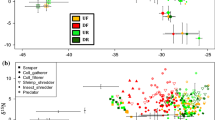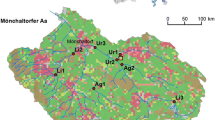Abstract
While recent research has provided evidence that the emergence of merolimnic insects (species with an aquatic larval stage) provides a considerable energy subsidy to riparian food webs, it has also shown that merolimnic insects may serve as a vector for contaminants. Therefore, riparian food webs may be at risk from either an aquatic-terrestrial transfer of contaminants or from the contaminant-driven reductions of emerging merolimnic insects. The objective of the present study was to develop an integrated stream mesocosms test design capable of identifying these inter-ecosystem boundary effects and to provide a comprehensive approach as a basis for ecotoxicological testing. We chose the widely distributed web-building spider Tetragnatha extensa as a representative species for riparian predators. Trophic aspects of riparian food webs were investigated by stable isotope analysis of carbon (δ13C) and nitrogen (δ15N). Utilization of stable isotope ratios provided detailed information on the riparian food web structure and the dietary composition of T. extensa. Merolimnic invertebrates (mainly Cloeon spp. and Chironomidae) were found to contribute up to 71 % of T. extensa’s diet, demonstrating their importance in riparian food webs in ecotoxicological mesocosm testing. This study provides a conceptual and methodological basis for assessing aquatic insect emergence-related pollutant transfer or effect translation from aquatic to adjacent terrestrial systems.






Similar content being viewed by others
References
Akamatsu F, Toda H (2011) Aquatic subsidies transport anthropogenic nitrogen to riparian spiders. Environ Pollut 159:1390–1397. doi:10.1016/j.envpol.2011.01.005
Akamatsu F, Toda H, Okino T (2004) Food source of riparian spiders analyzed by using stable isotope ratios. Ecol Res 19:655–662. doi:10.1007/s11284-005-0038-9
Anderson MJ (2001) A new method for non-parametric multivariate analysis of variance. Aust Ecol 26:32–46
Bährmann R (Hrsg.), Müller HJ (2011) Classification of invertebrates: plates for zoological determination and excursions. 6. edition, Spektrum Akademischer Verlag, Heidelberg (in German)
Ballinger A, Lake PS (2006) Energy and nutrient fluxes from rivers and streams into terrestrial food webs. Mar Freshw Res 57:15–28. doi:10.1071/MF05154
Bauernfeind E, Humpesch UH (2001) The mayflies of Central Europe (Insecta: Ephemeroptera)—classification and ecology. Wien, Verlag des Naturhistorischen Museums Wien (in German)
Baxter CV, Fausch KD, Saunders WC (2005) Tangled webs: reciprocal flows of invertebrate prey link streams and riparian zones. Freshw Biol 50:201–220. doi:10.1111/j.1365-2427.2004.01328.x
Blanchette ML, Davis AM, Jardine TD, Pearson RG (2014) Omnivory and opportunism characterize food webs in a large dry-tropics river system. Freshwat Sci 33:142–158. doi:10.1086/674632
Chinery M (1984) Insekten Mitteleuropas. A classification guide for zoologists and nature enthusiast. 3. revised edition. Parey. Hamburg (in German)
Daley JM, Corkum LD, Drouillard KG (2011) Aquatic to terrestrial transfer of sediment associated persistent organic pollutants is enhanced by bioamplification processes. Environ Toxicol Chem 30:2167–2174. doi:10.1002/etc.608
Elsaesser D, Stang C, Bakanov N, Schulz R (2013) The Landau Stream Mesocosm Facility: pesticide mitigation in vegetated flow-through streams. Bull Environ Contam Toxicol 90:640–645. doi:10.1007/s00128-013-0968-9
European Food Safety Authority (2013) Guidance on tiered risk assessment for plant protection products for aquatic organisms in edge of-field surface waters. EFSA J 11:3290, 186 p
Fairchild WL, Muir DCG (1992) Emerging insects as a biotic pathway for movement of 2,3,7,8-tetrachlorodibenzofuran from lake sediments. Environ Toxicol Chem 11:867–872. doi:10.1002/etc.5620110614
Gergs R, Koester M, Schulz RS, Schulz R (2014) Potential alteration of cross-ecosystem resource subsidies by an invasive aquatic macroinvertebrate: implications for the terrestrial food web. Freshw Biol 59:2645–2655. doi:10.1111/fwb.12463
Gillespie RG, Caraco T (1987) Risk-sensitive foraging strategies of two spider populations. Ecology 68:887–899
Gray LJ (1989) Emergence production and export of aquatic insects from a tallgrass prairie stream. Southwest Nat 34:313–318
Haubert D, Langel R, Scheu S, Ruess L (2005) Effects of food quality, starvation and life stage on stable isotope fractionation in Collembola. Pedobiologia 49:229–237. doi:10.1016/j.pedobi.2004.11.001
Haupt J, Haupt H (1998) Flies and midges: observations, life cycle. Naturbuch, Augsburg (in German)
Henschel JR, Mahsberg D, Stumpf H (2001) Allochthonous aquatic insects increase predation and decrease herbivory in river shore food webs. Oikos 93:429–438. doi:10.1034/j.1600-0706.2001.930308.x
Hobson KA, Alisauskas RT, Clark RG (1993) Stable-nitrogen isotope enrichment in avian tissues due to fasting and nutritional stress: implications for isotopic analyses of diet. Condor 95:388–394
Iwata T (2006) Linking stream habitats and spider distribution: spatial variations in trophic transfer across a forest–stream boundary. Ecol Res 22:619–628. doi:10.1007/s11284-006-0060-6
Jackson JK, Fisher SG (1986) Secondary production, emergence, and export of aquatic insects of a Sonoran Desert stream. Ecology 67:629–638
Johannsen OA (1977) Aquatic Diptera. Los Angeles, Entomological Reprint Specialists
Kato C, Iwata T, Nakano S, Kishi D (2003) Dynamics of aquatic insect flux affects distribution of riparian web‐building spiders. Oikos 103:113–120. doi:10.1034/j.1600-0706.2003.12477.x
Kawaguchi Y, Nakano S (2001) Contribution of terrestrial invertebrates to the annual resource budget for salmonids in forest and grassland reaches of a headwater stream. Freshw Biol 46:303–316. doi:10.1046/j.1365-2427.2001.00667.x
Kawaguchi Y, Taniguchi Y, Nakano S (2003) Terrestrial invertebrate inputs determine the local abundance of stream fishes in a forested stream. Ecology 84:701–708
McArdle BH, Anderson MJ (2001) Fitting multivariate models to community data: a comment on distance-based redundancy analysis. Ecology 82:290–297
McCutchan JH, Lewis WM, Kendall CK, McGrath C (2003) Variation in trophic shift for stable isotope ratios of carbon, nitrogen, and sulfur. Oikos 102:378–390
Otter RR, Hayden M, Mathews T et al (2013) The use of tetragnathid spiders as bioindicators of metal exposure at a coal ash spill site. Environ Toxicol Chem 32:2065–2068. doi:10.1002/etc.2277
Paetzold A, Tockner K (2005) Effects of riparian arthropod predation on the biomass and abundance of aquatic insect emergence. J N Am Benthol Soc 24:395–402. doi:10.1899/04-049.1
Paetzold A, Schubert CJ, Tockner K (2005) Aquatic terrestrial linkages along a braided-river: riparian arthropods feeding on aquatic insects. Ecosystems 8:748–759. doi:10.1007/s10021-005-0004-y
Paetzold A, Sabo JL, Sadler JP, Findlay SEG, Tockner K (2008) Aquatic–terrestrial subsidies along river corridors. In: Wood PJ, Hannah DM, Sadler JP (eds) Hydroecology and ecohydrology: past, present and future. Wiley, Chichester. doi:10.1002/9780470010198.ch4
Parnell AC, Inger R, Bearhop S, Jackson AL (2010) Source partitioning using stable isotopes: coping with too much variation. PLoS One 5:e9672. doi:10.1371/journal.pone.0009672
Paul D, Skrzypek G, Fórizs I (2007) Normalization of measured stable isotopic compositions to isotope reference scales—a review. Rapid Commun Mass Spectrom 21:3006–3014. doi:10.1002/rcm.3185
Phillips DL, Koch PL (2002) Incorporating concentration dependence in stable isotope mixing models. Oecologia 130:114–125. doi:10.1007/s004420100786
Phillips DL, Newsome SD, Gregg JW (2005) Combining sources in stable isotope mixing models: alternative methods. Oecologia 144:520–527. doi:10.1007/s00442-004-1816-8
Ponsard S, Arditi R (2000) What can stable isotopes (δ15N and δ13C) tell about the food web of soil macro-invertebrates? Ecology 81:852–864
Quinn J, Cooper A, Davies-Colley R et al (1997) Land use effects on habitat, water quality, periphyton, and benthic invertebrates in Waikato, New Zealand, hill‐country streams. N Z J Mar Freshw Res 31(5):579–597
R Core Team (2014) R: a language and environment for statistical computing. R Foundation for Statistical Computing, Vienna, Austria. URL http://www.R-project.org/
Raikow DF, Walters DM, Fritz KM, Mills MA (2011) The distance that contaminated aquatic subsidies extend into lake riparian zones. Ecol Appl 21:983–990
Sanzone DM, Meyer JL, Marti E et al (2003) Carbon and nitrogen transfer from a desert stream to riparian predators. Oecologia 134:238–250. doi:10.1007/s00442-002-1113-3
Schmidt TS, Kraus JM, Walters DM, Wanty RB (2013) Emergence flux declines disproportionately to larval density along a stream metals gradient. Environ Sci Technol 47:8784–8792. doi:10.1021/es3051857
Schulz R, Liess M (2001) Acute and chronic effects of particle-associated fenvalerate on stream macroinvertebrates: a runoff simulation study using outdoor microcosms. Arch Environ Contam Toxicol 40:481–488. doi:10.1007/s002440010200
Smith JA, Mazumder D, Suthers IM, Taylor MD (2013) To fit or not to fit: evaluating stable isotope mixing models using simulated mixing polygons. Methods Ecol Evol 4:612–618. doi:10.1111/2041-210X.12048
Stang C, Wieczorek MV, Noss C et al (2014) Role of submerged vegetation in the retention processes of three plant protection products in flow-through stream mesocosms. Chemosphere 107:13–22. doi:10.1016/j.chemosphere.2014.02.055
Stehle S, Elsaesser D, Gregoire C et al (2011) Pesticide risk mitigation by vegetated treatment systems: a meta-analysis. J Environ Qual 40:1068–1080. doi:10.2134/jeq2010.0510
Tank JL, Rosi-Marshall EJ, Griffiths NA et al (2010) A review of allochthonous organic matter dynamics and metabolism in streams. J N Am Benthol Soc 29:118–146. doi:10.1899/08-170.1
Tsui MTK, Blum JD, Kwon SY et al (2012) Sources and transfers of methylmercury in adjacent river and forest food webs. Environ Sci Technol 46:10957–10964. doi:10.1021/es3019836
Walters DM, Fritz KM, Otter RR (2008) The dark side of subsidies: adult stream insects export organic contaminants to riparian predators. Ecol Appl 18:1835–1841
Walters DM, Mills MA, Fritz KM, Raikow DF (2010) Spider-mediated flux of PCBs from contaminated sediments to terrestrial ecosystems and potential risks to arachnivorous birds. Environ Sci Technol 44:2849–2856. doi:10.1021/es9023139
Wiley M, Osborne LL, Larimore RW (1990) Longitudinal structure of an agricultural prairie river system and its relationship to current stream ecosystem theory. Can J Fish Aquat Sci 47:373–384
Williams DD, Ambrose LG, Browning LN (1995) Trophic dynamics of two sympatric species of riparian spider (Araneae: Tetragnathidae). Can J Zool 73:1545–1553
Wise D (1995) Spiders in ecological webs. Cambridge University Press, Cambridge
Author information
Authors and Affiliations
Corresponding author
Additional information
Responsible editor: Hailong Wang
Rights and permissions
About this article
Cite this article
Wieczorek, M.V., Kötter, D., Gergs, R. et al. Using stable isotope analysis in stream mesocosms to study potential effects of environmental chemicals on aquatic-terrestrial subsidies. Environ Sci Pollut Res 22, 12892–12901 (2015). https://doi.org/10.1007/s11356-015-4071-0
Received:
Accepted:
Published:
Issue Date:
DOI: https://doi.org/10.1007/s11356-015-4071-0




